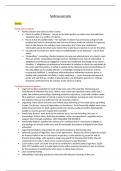Summary
Summary Family Law units 1-9 FULL EXAM NOTES 91% distinction
- Course
- Institution
This document provides full notes on units 1-9 family law at the University of Law. These notes have been created using both LPC Buddy and the Family Law textbook and therefore include everything you need to know for the exam. includes: a detailed summary of all units, practice questions and an...
[Show more]



